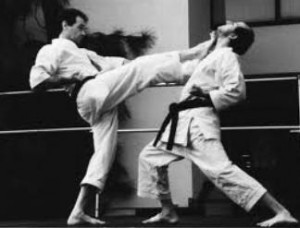Any technique can be developed into a number of variations. However, when it comes to the front kick, I would say that there are main variations (and many sub-variations). These are hips side-on (FIG 1: hips facing about 90 degrees to opponent) and hips forward (FIG 2: hips facing toward the opponent).
Both have slightly different advantages which I’d like to explore. But firstly I want to make it clear, I’m not saying that one kick can ONLY be used ONE WAY and the other version can only be used ANOTHER WAY, as that would be silly. What I would say however is that each version is optimised for different purposes.

If we start with the hips side on version first. This variation gives a slightly longer range. It is also easier for doing a front leg kick. If you get into a fighting stance with your weight on your back leg and your feet more or less in line, it becomes very easy to raise the front leg of the ground and kick with it. This give you a better chance of keeping an opponent at a distance due to it’s additional range (especially compared with hands) and speed.
The hips forward version however has slightly less range, but it does put more actually body weight behind the kick.
This gives it more stopping power for somebody charging in. Generally speaking, your body weight moves in the direction that the hips face.

Another detail is the position of the supporting foot. If you look at Fig 1, you’ll see that the supporting foot is also pointing at about 90 degrees away from the opponent. This is necessary or the supporting leg would be twisted and could do hip/knee damage. However, if the opponent is able to absorb the kicks impact and keep moving forward, then the supporting foot will end up resisting the push on the little toe side of the foot which is obviously weaker. The kicker could find themself being unbalanced and pushed back.
With the hips forward version at Fig 2, you’ll see that the supporting foot is facing forward too. Firstly, being able to put more body weight into the kick means it would take more for the opponent to overcome and even be able to move forward. Secondly, as the supporting foot is pointing forward, it is able to dig into the floor with the heal of the foot which will afford more resistance than the little toe side of the foot to any pressure being applied by an opponent absorbing the kick and trying to push through.
The hips facing forward (Fig 2) is the older version of the kick and the hips side on version (Fig 1) was developed later. Why? The hips side on version is better for the sport environment. Although in sport, the opponent is still trying to hit/kick/strike you, because there are rules the opponent is still partially co-operative. Unless you are in competing in Mixed Martial Arts cage fights, most competitions (traditional martial arts/Kickboxing) do not allow you to grab or grapple. Therefore the opponent is usually co-operative in that they are staying at kicking/striking range and not trying to rush in at you.
This creates an environment where that little bit of extra range is useful and the weakness on the supporting foot is not an issue.
However, the hips forward version has limitations in the sporting arena but has more stopping power in the street. In a real assault, the attacker will not be co-operative in any way at all and will most likely be charging forward to grab you. Most street fighters/muggers/etc are not martial artists so would not fight the same way. Therefore range is not an issue as the chances are that your attacker will be closing distance straight away (especially for assaults on women).
I am not suggesting that you should practice one way or the other, all I would suggest is that be aware of what you are training for and chose the appropriate version of this technique.

Sensei Wildish
Enjoyed the article. The front kick gets a lot of negative press but I still find it one of the most versatile kicks.
You might enjoy my article on its basics.
http://oldmankarate.com/2012/09/front-kick-basics/
Hello Sensei
Thanks for the feedback and the link to your post. I agree with you, as well as being very versatile I also think it is one of the safest to commit to under pressure.
Very well written 🙂 The front kick is an excellent straight forward technique
Hans
Thank you and I completely agree with you about the front kick. Basic but effective!
Actually, you ARE allowed to grab in Muay Thai and some forms of kickboxing. In fact, the clinch is where much of the fighting happens in Muay Thai. A fighter using the front push kick in Muay Thai is trying to force his opponent away; you’ll actually be able to find plenty of footage of Nak Muay knocking their opponents back as they try to close the distance in real matches on Youtube.
Hi Joseph
Point taken, I stand corrected. When I wrote this I was think more in terms of full on grappling, but I did say “grab”, so I fully accept your correction, thank you 🙂
I have corrected the sentance in question.